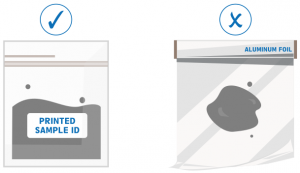U-Th Dating – Sample Types and Selection
The following sample size recommendations are general guidelines. Please contact us if you are concerned that your samples are too small.
Reminders:
- Do not leach samples for cleaning, even with weak acid, as leaching has been shown to significantly affect the uranium concentration in the sample, leading to erroneous ages.
- DO NOT wrap samples in aluminum or any metal foil. Use weighing paper if you need to wrap them.
- Submit samples in a ziplock bag or teflon container with PRINTED SAMPLE ID attached outside the bag.

Always choose the best samples for your research objectives
Our recommended sample sizes assume the material is dry and free of adhering matrix.
Bone, Tooth, Shell
100-150 mg
RECOMMENDED CONTAINERPlastic or glass vials
Put them inside a labeled Ziplock bag
The laboratory is able to conduct U-Th on these sample types, however, since they are considered an open system with respect to uranium and thorium, they may yield aberrant/erroneous ages.
Due to the porous nature of the bone it can easily react with its burial environment and can trap detrital particles. The bone porosity varies between different bones and even within a single bone. As a result different bones from one individual or different parts of a single bone may contain different amounts of detritals. The amount of detrital can not be easily evaluated or predicted as it is very difficult to distinguish between the collagen particles and detrital materials after digestion unless running specific tests. Additionally, the contribution of detrital to initial thorium values and the openness of the system cannot be predicted unless we complete the analysis and calculate the activity ratios.
Bulk Carbonates
100-150 mg
RECOMMENDED CONTAINERPlastic or glass vials
Put them inside a labeled Ziplock bag
For the best results, make sure your samples are clean and free from soil, clay particles, calcite and other detritus. Samples should be homogenized prior to submission.
Coral
30-50 mg
RECOMMENDED CONTAINERGlass or plastic vials
For the best results, make sure your samples are clean and free from clay particles and other detritus. It is highly recommended to check the mineralogy of your sample. Choose samples with the highest amount of aragonite. Homogenize your samples, preferably using an agate mortar and pestle, and transfer into plastic or glass vials. Homogenized samples are digested in 6 M nitric acid (lower concentrations may be used if the sample contains clay and detritus).
ALSO AVAILABLE:Gypsum
1000 mg
RECOMMENDED CONTAINERPlastic or glass vials
Gypsum microcrystals and gypsiferous (gypsum-rich) sediments: Gypsiferous sediments and gypsum microcrystals contain large quantities of detritic materials. Isolation of gypsum crystals from the matrix fragments must be conducted prior to sample submission. If this is not feasible by the client, Isobar Science offers isolation of gypsum crystals by means of density separation for an additional charge.
Must be received dry and homogenized or extra charge will be applied.
ALSO AVAILABLE:Stalagmite and Flowstone
100-150 mg
RECOMMENDED CONTAINERGlass or plastic vials
Homogenize your samples, preferably using an agate mortar and pestle, and transfer into plastic or glass vials. Homogenized samples are digested in 6 M nitric acid.
ALSO AVAILABLE:Carbonate Crust
100-150 mg
RECOMMENDED CONTAINERZiplock bags or plastic centrifuge tubes
For the best results, make sure your samples are clean and free from clay particles and other detritus.
ALSO AVAILABLE:- None at this time
NOTES:
- All samples will be screened for U and excess Th prior to isotope dilution and extraction chromatography processes for purification and measurement. Only samples with acceptable ranges of Th will be selected for analysis. If a sample is considered not suitable for analysis, the client will only be charged for the screening.
- Samples that did not remain closed with respect to U and Th isotopes will yield ages that may not fit in with established chronologies.
- We utilize an analytical method which provides precise measurement of 233U-234U-235U-236U-238U-229Th-230Th-232Th with high resolution whether a sample remained closed with respect to U and Th or displays open system behavior.
Please consult the lab before submitting samples.
Duration: 2 minutes, 30 seconds || Speaker: Maren Pauly, PhD
This video excerpt is part of Isobar Science’s webinar: An Introduction to Uranium-Thorium Dating.
Disclaimer: This video is hosted in a third-party site and may contain advertising.
Page last updated: November 2019
